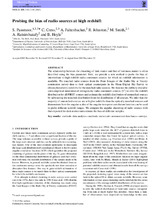| dc.contributor.author | Passmoor, S. | |
| dc.contributor.author | Cress, Catherine | |
| dc.contributor.author | Faltenbacher, Andreas | |
| dc.contributor.author | Johnston, Russell | |
| dc.contributor.author | Smith, Mathew | |
| dc.contributor.author | Ratsimbazafy, Ando | |
| dc.contributor.author | Hoyle, Ben | |
| dc.date.accessioned | 2017-07-27T08:54:28Z | |
| dc.date.available | 2017-07-27T08:54:28Z | |
| dc.date.issued | 2013 | |
| dc.identifier.citation | Passmoor, S. et al. (2013). Probing the bias of radio sources at high redshift. Monthly Notices of the Royal Astronomical Society, 429: 2183–2190 | en_US |
| dc.identifier.issn | 0035-8711 | |
| dc.identifier.uri | http://hdl.handle.net/10566/3113 | |
| dc.description.abstract | The relationship between the clustering of dark matter and that of luminous matter is often
described using the bias parameter. Here, we provide a new method to probe the bias of
intermediate-to-high-redshift radio continuum sources for which no redshift information is
available. We matched radio sources from the Faint Images of the Radio Sky at Twenty
centimetres survey data to their optical counterparts in the Sloan Digital Sky Survey to
obtain photometric redshifts for the matched radio sources.We then use the publicly available
semi-empirical simulation of extragalactic radio continuum sources (S3) to infer the redshift
distribution for all FIRST sources and estimate the redshift distribution of unmatched sources
by subtracting the matched distribution from the distribution of all sources. We infer that the
majority of unmatched sources are at higher redshifts than the optically matched sources and
demonstrate how the angular scales of the angular two-point correlation function can be used
to probe different redshift ranges. We compare the angular clustering of radio sources with
that expected for dark matter and estimate the bias of different samples. | en_US |
| dc.language.iso | en | en_US |
| dc.publisher | Oxford University Press | en_US |
| dc.rights | Copright the Authors. Authors may archive the published version in their institutional repository. | |
| dc.source.uri | http://dx.doi.org/10.1093/mnras/sts488 | |
| dc.subject | Data analysis – methods | en_US |
| dc.subject | Statistical – astronomical data bases – surveys | en_US |
| dc.subject | Methods | en_US |
| dc.title | Probing the bias of radio sources at high redshift | en_US |
| dc.type | Article | en_US |
| dc.description.accreditation | Web of Science | |

